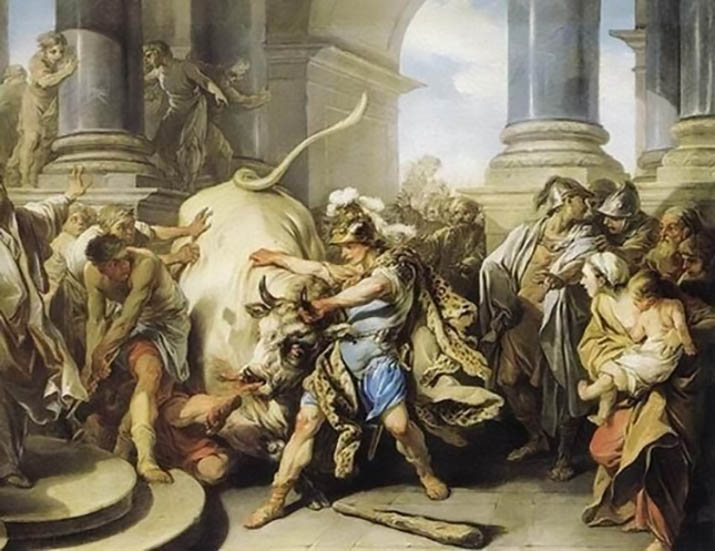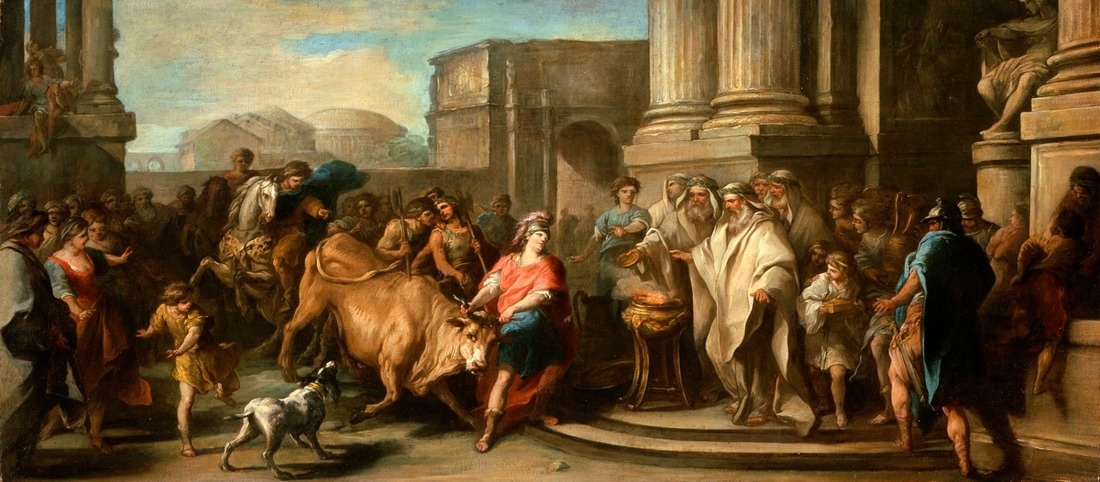
Cretan / Marathonian Bull

The Father of the famous Minotaur
In Greek mythology, the Cretan Bull was the bull Pasiphaë fell in love with, giving birth to the Minotaur.
The Background
Minos was king in Crete. In order to confirm his right to rule, rather than any of his brothers, he prayed to Poseidon; and Poseidon did send him a snow-white bull as a sign. Poseidon sent Minos the bull, with the understanding that steer would be sacrificed to the god.
Deciding that Poseidon's bull was too fine of a specimen to kill, Minos sent the bull to his herds and substituted another, inferior bull for sacrifice. Enraged, Poseidon had Aphrodite cause Pasiphaë, wife of Minos, to fall in love with the bull. She subsequently gave birth to the half-man, half-bull, Minotaur. Poseidon passed on his rage to the bull, causing him lay waste to the land.
After consulting the oracle at Delphi, Minos had Daedalus construct the Labyrinth to hold the Minotaur.
The seventh labour of Heracles: THE CRETAN BULL BECOMES THE MARATHONIAN BULL
Heracles was sent to capture the bull by Eurystheus as his seventh task. He sailed to Crete, whereupon Minos gave Heracles permission to take the bull away as he had been wreaking havoc on Crete by uprooting crops and leveling orchard walls. Heracles captured the bull, and then shipped him to Eurystheus in Tiryns.
The bull later broke loose and wandered into Marathon, becoming known as the "Marathonian Bull". Eurystheus then sent Heracles to bring back the man-eating Mares of Diomedes (the next labour).

Capture by Theseus
Androgeus, a son of Minos and Pasiphaë, competed in the games held by Aegeus, King of Athens. He won all the games, but the bull, which broke free from his pen, rampaged through the city and trampled Androgeus. Devastated, Minos went to war with Athens and won. As punishment, the Athenians had to send several youths every 9 years to be devoured by the Minotaur.
Theseus set out to try to capture the bull. On the way to Marathon, Theseus sought shelter from a storm in the shack owned by an old lady named Hecale. She swore to make a sacrifice to Zeus if Theseus was successful in capturing the bull. Theseus did capture the bull, but when he returned to Hecale's hut, she was dead. Theseus built a deme in her honour.
He then dragged the bull to Athens where he sacrificed him to Athena and/or Apollo. Thus the life of the Cretan Bull ended in Athens.
Theseus then went to Crete where he killed the Minotaur with the help of Minos' daughter Ariadne.
Astronomy and Popular Culture
Taurus is one of the oldest observed constellations, and has been variously connected with the abduction of Europa, the seduction of Io, and the Cretan Bull.
The Taurid meteor shower is named after the radiant point in the constellation Taurus, from where they are seen to come. Occurring in late October and early November, they are sometimes called "Halloween fireballs".
Also, in the video game Assassin's Creed Odyssey, there is a side quest where the player fights the bull.

Sources
"The Cretan Bull", The Perseus Project, (Gregory R. Crane, ed.), Tufts University
Pseudo-Apollodorus, Bibliotheca 2.5.7
McInerney, Jeremy. "Bulls and Bull-leaping in the Minoan World", Penn Museum
Dietrich, Bernard Clive. "Some Older Traditions in Minoan Crete", The Origins of Greek Religion, Walter de Gruyter, 1974
Powell, Barry B., "Cretan Mythology", The Oxford Encyclopedia of Ancient Greece and Rome, Vol. 7, Oxford University Press, 2009
Stafford, Emma. "The Cretan bull", Herakles, Routledge, 2013
Falkner, David E., "Winter constellations", The Mythology of the Night Sky, The Patrick Moore Practical Astronomy Series, 2011
Lewis, Charles Bertram. Classical Mythology and Arthurian Romance, Slatkine, 1974
Our Mobile Application
Check out Our Mobile Application "Ancient Greece Reloaded"


